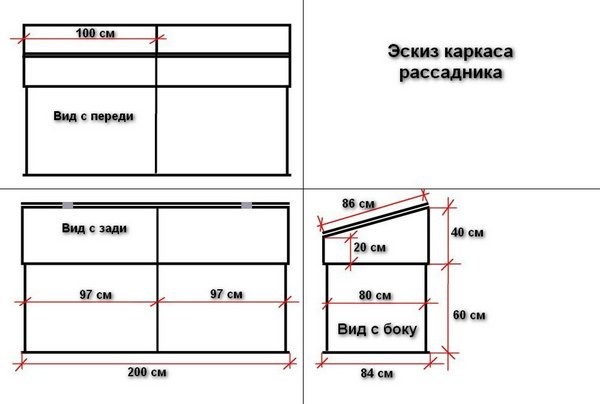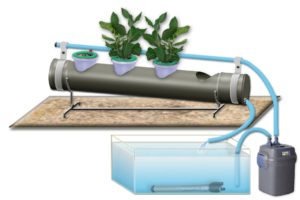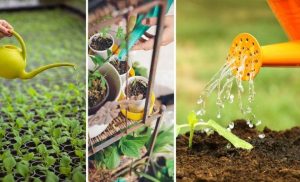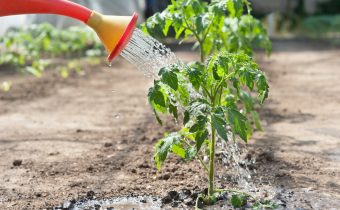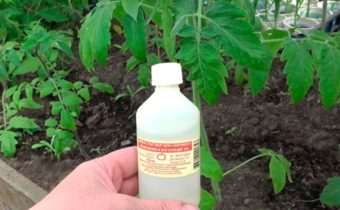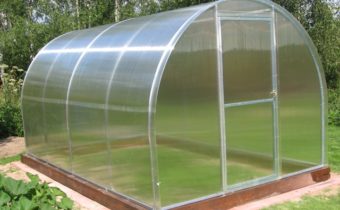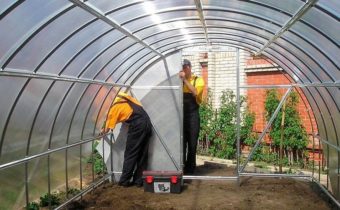Irrigation system for the greenhouse do it yourself
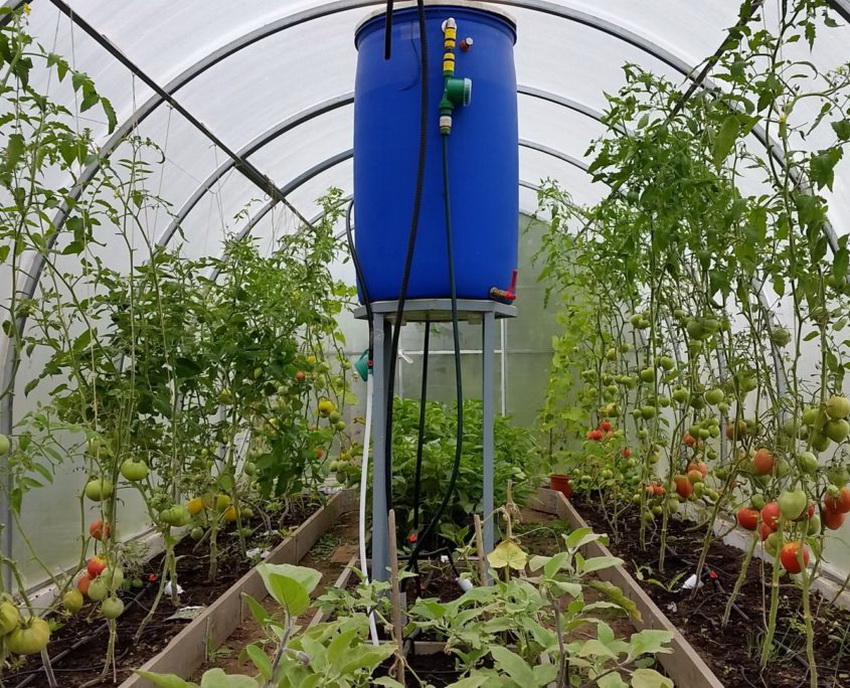
Drip irrigation saves time and effort. You can make it from scrap materials with your own hands or purchase a ready-made industrial system. Practice has shown that when using this irrigation option, the yield of vegetable crops is increased by 30%.
Drip irrigation, pros and cons
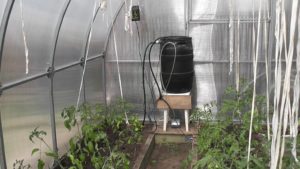
Any summer resident can organize drip irrigation in the greenhouse. The stores have sets with clear descriptions of the assembly process. The simplest irrigation system for a small greenhouse can be collected from scrap materials.
Arguments in favor of drip irrigation are more than enough:
- Water enters the root zone of a vegetable plant. The greenhouse creates comfortable conditions for their development, there is no condensate on the leaves, the soil and air humidity levels are optimal, and the soil is not crusted.
- With targeted water supply its consumption is less, it allows to reduce costs.
- For operation, a large pressure in the supply pipes is not required, 0.2 atm is sufficient for water to enter the greenhouse beds.
- There is no big difference between the temperature of water and air, it favorably affects the health and development of greenhouse crops. In the configuration of each drip irrigation system there is a tank (source) in which the water is defended before the irrigation, warms up.
- You can water the beds at any time, even at night, and when automating the process without people.
- Root top dressing can be combined with irrigation by adding a liquid solution of fertilizers in the irrigation tank.
The main argument - saving time and strength gardener. Caring for vegetables in the greenhouse becomes much more comfortable. With less labor, the yield of greenhouse beds is increasing.
Cons find difficult. To the shortcomings do not include the cost of components, the time spent on installation and maintenance of the system in working condition.
Operating principle
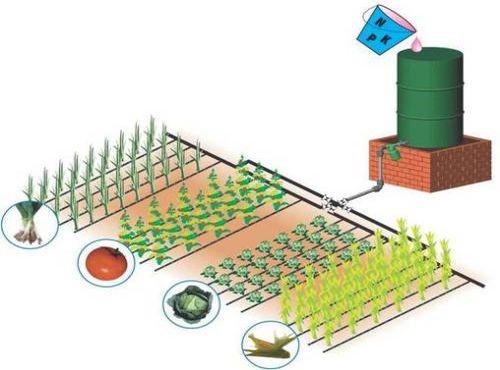 With the help of trunk pipes and a network of drip lines, water is supplied to the plant root system. It accumulates in the storage tank - the source or is supplied directly from the water supply network. On the highway water flows from the tank into the greenhouse. There it is distributed by drip through the beds.
With the help of trunk pipes and a network of drip lines, water is supplied to the plant root system. It accumulates in the storage tank - the source or is supplied directly from the water supply network. On the highway water flows from the tank into the greenhouse. There it is distributed by drip through the beds.
In order for the system to work smoothly, use a water filter. He warns of blockages. Install it on the source. A pump is needed if water for irrigation is taken from a well, a well, a natural reservoir (pond, lake, river). With it, pump the required volume of fluid in the barrel.
To assemble droppers and hoses into a single system, you need to purchase:
- fitting;
- faucet, it will regulate the water flow;
- ball valve to stop the water supply;
- adapters to connect pipes with different diameters.
Fittings are plugs, tees, corners. For their connection with hoses there is no need for special tools. To equalize the pressure in the pipes, special devices may be needed:
- gearbox;
- mini crane;
- anti-drain valves.
Types of droppers
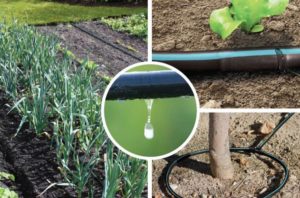
The main element of the system is a dropper. Its second name is emitter. It is a device for dispensing fluid. By type of installation emitters are internal and external. Exterior models have a long service life. They are easy to attach to PVC hoses. Type of outdoor emitters:
- compensated;
- uncompensated.
The use of compensated external droppers ensures a uniform supply of water throughout the entire length of the system, even if the feed pipes lie at different heights.
The table shows the popular models of external droppers of compensated type.
| Model | Variety |
Description
|
Comment | |
| SuperTif
compensated |
tubes and tips | 1 | used in low-volume systems with a pulsed water supply | |
| 2 | the possibility of using splitters for the organization of simultaneous irrigation of 2-3 plants | |||
| 4 | ||||
| working pressure (atm) | 06-3,5 | |||
| Katif | push button | working pressure (atm) | 0,4-3,0 | Mounted in flexible hoses with wall thickness ≤ 1.5 mm |
| compensated | water consumption (l / h) | 2 | ||
| 4 | ||||
| 8 | ||||
| ND Super Drop | compensated | tips
|
1 | convenient model for greenhouses |
| 2 | ||||
| 4 | ||||
| working pressure (atm) | 0,6-3,5 | |||
| water consumption (l / h)
|
1,1 | |||
| 2,2 | ||||
| 3,85 | ||||
| 7,8 | ||||
Non-compensated droppers are suitable for small-sized greenhouses with a short line:
- HY1208-4 k / x;
- drip-box, several models with a flow rate of 4, 8, 16 l / h;
- three models of collapsible droppers with a labyrinth, flow rate 2, 4, 8 l / h.
Droppers of internal type are built in tapes, they happen 3 types:
- maze;
- crevice;
- emitter
The tape of the first type on the outer surface has a channel configuration resembling a labyrinth. With it, there is a drip supply of water. This model of tapes is not durable, soil moistening is uneven.
The second type of irrigation belts differs from the first in that the labyrinth channel passes inside. This makes the design more reliable and durable. For the normal functioning of the system requires high-quality cleaning filters.
Emitter drip tapes can serve up to 3 seasons. Water is supplied through flat labyrinth droppers. They are designed in such a way that they create turbulent flows, with the help of which the emitters self-clean.
Droppers embedded in the tape with a certain step. The smaller the distance between the emitters, the tape is more expensive. In systems with emitter-type drip tapes, simple filter models can be used.
| Drip tape | Type of | Specifications |
| Turboslim | emitter | 1.2 l / h |
| 40 cm | ||
| 16 mm | ||
| Tuboflex
|
emitter
|
1.6 l / h |
| 30 cm | ||
| 16 mm | ||
| Aqua-traxx | crevice | 1.14 l / h |
| 10 cm | ||
| 16 mm |
Water the seedlings of tomatoes correctly so that it is strong and does not stretch.
To get healthy and chunky tomato seedlings, it is important to know the finer points of watering. Do beginner gardeners who ...
The distance between the droppers, nozzles
For most greenhouse crops (tomatoes, strawberries, eggplants, peppers, cucumbers) the optimal distance between emitters is 30 cm. A smaller pitch (20 cm) is suitable for ridges on which root crops (beets, carrots) and onions are grown.
For a small greenhouse need a capacity of 200 liters. For this purpose, suitable barrels of plastic, carbon steel, stainless steel.
Calculation of water volume and duration of irrigation
For each vegetable culture its own irrigation rate is defined. It is taken as a basis for calculating water consumption. Tomatoes, peppers, cucumbers are usually grown in the greenhouse. At the design stage, systems take averaged values.
| Culture | Daily water consumption per 1 plant (l) |
| tomato | 1,5 |
| cucumber | 2 |
| pepper | 1,6 |
When designing the system take into account:
- planting scheme - the number of plants of this species planted on 1 m²;
- diameter of the adjustable pipeline, its capacity m³ / h;
- distance between irrigation belts;
- distance between droppers (emitters);
- consumption of one emitter (l / h).
Knowing the number of plants planted per unit area, determine the maximum rate of irrigation (Q). To find out the duration of watering (T), calculate the water consumption with droppers (R). The formula for calculating R = number of droppers per unit area * water consumption. Watering time T = Q / R.
It takes less than an hour to supply water if in a greenhouse where cucumbers grow, irrigation system is organized with emitters supplying water at a speed of 3 l / h. Under the same conditions, it will take 30 minutes to water the tomatoes.
Automated systems
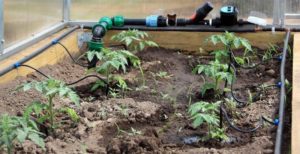
For the organization of a drip irrigation system in the greenhouse, a set of drip irrigation, calculated for its volume, is acquired. If the filter is not included, it is purchased separately. To automate the process, select the appropriate models:
- sensors;
- electromagnetic controller;
- timer for drip irrigation.
A controller is a mini-computer with which a watering program is set. Single-channel models are suitable for small greenhouses, they are designed to organize automatic irrigation in one zone.
In order for the Signor Tomato system to work, electricity is not required. Automatic watering occurs due to the energy generated by the solar battery. It is included.
For automated irrigation of several zones, multichannel controllers are used. They work from the mains or batteries. Programmable devices receive data from sensors on soil moisture and air temperature. Based on their values, the duration and frequency of the feed is adjusted.
Assembly stages
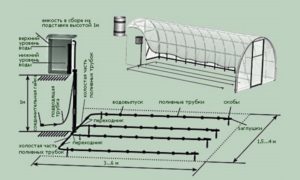
You can assemble a drip water supply system from a tank with a capacity of 100-200 liters, plastic pipes and medical droppers. The barrel is installed at a height of 1-2 meters. The greater the height, the greater the pressure in the system.
At the bottom of the barrel cut tap. To purify water from mechanical impurities, they acquire an inexpensive model of the filter, install it after the tap. The supply pipe is brought into the greenhouse.
In the drip irrigation system is to include a feeding unit. With it, during irrigation, liquid mineral fertilizers can be supplied to the plants.
Water should flow to each ridge. The number of feeding plastic pipes is equal to the number of beds. Wiring done with a tee and corners. To regulate the flow of water, a tap is installed on each branch. On each delivery pipe put a cap.
Count how many plants will be planted on each ridge. It will take as many medical droppers. Markers make markup, drill holes drilled. One end of the dropper stick into the tube, put the second in the hole. The feed control allows you to adjust the intensity of irrigation.
Which system is better?
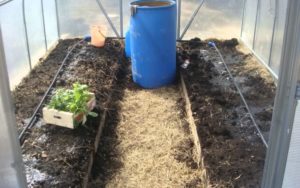
On sale there is a line of the Belarusian systems Akvadusya. Products are in demand. There is an Aqua automatic machine, in it all the processes are automated:
- in the daytime, without the presence of a person, the storage tank is filled with water;
- automatic watering occurs in the dark.
The AquaDusia model is a semi-automatic machine, without a person, it works out watering, the water tank is filled manually. Third option
Russian products are in demand:
- Beetle;
- Clip-36.
The model Beetle for small greenhouses is designed for an area of 18 m². It is not automated. There are 2 types of products: one option with connection to the water supply network, the second - to the tank.
Clip-36 allows you to organize a round-the-clock supply of water to greenhouse ridges. It is served in thin streams at specific time intervals. Filing time from 1.5 to 2 minutes. The model can provide water area of 36 m². 2 connection options implemented:
- barrel;
- water pipes.
If Clip-36 model is connected to the water supply, all processes occur without human presence. In the version with a barrel, it is needed to fill it.Capacity in 200 l is enough for a week of continuous watering. The intensity of supply can be adjusted depending on the daily needs of vegetables, the range of 0.5-20 l / m².
You can evaluate the benefits of drip irrigation with ordinary plastic bottles. Suitable capacity of 2 liters. They need as much as bushes of tomatoes, cucumbers or peppers are planted in the greenhouse.
The bottom of the bottles cut stationery knife. At the top with an awl make holes. Through them, the water will flow to the roots of plants. Bottles set in each well, buried in the ground. Water every 3-4 days to fill with a hose or a watering can.
Errors
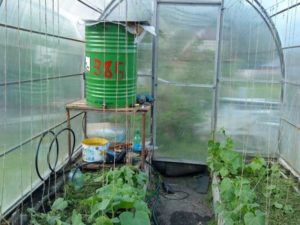
The adverse consequences are caused by mistakes made when operating the irrigation system:
- reduce irrigation rate;
- sticking to the wrong frequency of irrigation;
- due to miscalculations at the design stage, irrigation is uneven;
- the filter does not provide the necessary degree of purification.
The estimated number of drip tape and other components when you purchase should be increased by 20%.
Reviews
Andrey, 45 years old, Moscow region
I grow tomatoes in the greenhouse. This season I decided to make drip irrigation. Got a EuroCube. He wrapped his glassbone to the water warmed faster. To track the water level in the tank, made a float. I use droppers outside, stuck next to each tomato bush. Put the controller. It starts the irrigation process every 3 days for 2 hours.
Mikhail, 50 years old, Samara
Drip irrigation functions the 3rd year. The central highway with a diameter of 25 mm, Israel drip tape. For 3 years, the connectors are not changed. I serve water from 1 to 2 hours.
Anna, 40 years old, Kaliningrad
At the cottage a few greenhouses. For each, she placed a non-automated Aqua Dushu. Life has become easier. Mulch beds of dry lawn grass. I plan to make drip irrigation on the beds in the open field.
The use of drip irrigation in the greenhouse facilitates the care of plants, improves the microclimate, promotes the growth and development of vegetable crops.

